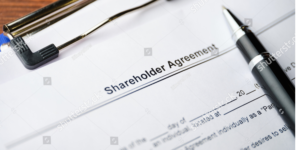In a company limited by shares, adding and removing company shareholders (members) may arise following an allotment or transfer of shares after incorporation. Any such changes must be reported to Companies House on the next annual confirmation statement.
Directors must update the company’s statutory register of members when shareholder information changes, ensuring that it is always accurate and up-to-date. In certain situations, the register of people with significant control (PSC register) must also be updated.
How to add new company shareholders
Companies can add new shareholders at any point after incorporation. The easiest way is for existing shareholders to transfer (sell or give away) some or all of their shares to new members. Alternatively, the company can increase its share capital by allotting (issuing) new shares.
Transferring shares
To transfer company shares, a stock transfer form (form J30) must be completed with the following details:
- Company name
- Class and value of the transferred shares (e.g. Ordinary shares of £1)
- Number of shares being transferred
- Name and contact address of the current shareholder (transferor)
- Name and contact of the new member (transferee)
- Consideration money or alternate form of non-cash payment, if applicable
- Stamp Duty liability, if any money is exchanged
- Signature of the transferor or authorised person
If money is paid for the transferred shares, a copy of the stock transfer form should be sent to HMRC to be stamped. The new shareholder must pay the required Stamp Duty to HMRC. If no money is paid, there is no need to file this form.
If the company’s articles of association include pre-emption rights on the transfer of shares, the existing members must waive their first refusal right. After that, the directors (or members, if required by the articles) can approve the transfer and update the register of members.
- Understanding pre-emption rights in a private limited company
- Rules and restrictions on share transfers in a private limited company
- Tax implications of transferring shares to your spouse or partner
New company shareholders should receive a share certificate as proof of purchase. The transferor and transferee should also receive a copy of the stock transfer form. The company must retain copies of the new and old certificates and the stock transfer form.
Notifying Companies House of the share transfer is not necessary until the next annual confirmation statement is due. However, filing a confirmation statement early is advisable. This ensures that the information shown on the Companies House register remains current.
Issuing new shares
Rather than transferring existing shares, companies can add new shareholders by issuing new shares. To do so, you must increase the company’s share capital. This procedure is known as an allotment of shares.
Creating new shares allows a company to add new members or raise additional funds without requiring existing shareholders to sell any of their shares. However, doing so will dilute the existing shareholders’ percentages of ownership and control in the company.
- A guide to transferring and issuing company shares
- Do shareholders need to pay for their shares?
- Bringing on a business partner – what you need to know
If the articles provide pre-emption rights on the allotment of shares, the existing members must first waive these rights. The prospective members should deliver a letter of application to the company, and the directors (or members, if required by the articles) must approve the allotment and update the register of members.
Within one month of issuing new shares, the directors must complete Companies House Form SH01 with the following information:
- Company name
- Company registration number
- Date(s) of the allotment(s)
- Class, currency, and number of new shares
- Nominal value of each unit
- Amount paid, or due to be paid, per share
- Details of any non-cash considerations (payments), if appropriate
- A statement of capital reflecting the new allotment
- Details of any shares allotted in a currency other than pound sterling
- Prescribed particulars of rights attached to shares
- Signature of a director or other authorised person
Companies House should receive information about the new member(s) when the next confirmation statement is due. Alternatively, the directors can file an early confirmation statement.
Suppose the company’s articles of association include a provision on authorised share capital (a maximum number and value of shares that the company can issue) and the allotment will take the company above that limit. In that case, the members must amend or remove the provision in the company’s articles beforehand.
How many shares can company shareholders take?
Company shareholders must take a minimum of one share each. There is no right or wrong quantity to issue. If you are setting up a company on your own, you can issue just one share. This share will represent 100% of the business. As such, you will be entitled to all profits and required to contribute the nominal value of your share(s) toward debts if the company cannot pay its bills.
If you plan to grow your business or bring in new partners at a later date, you should consider issuing more than one share when you set up your company. This will enable you to sell some of them in the future rather than having to create new shares.
- How many shares should I issue when I forming a company?
- Company shares for startups
- What are my shareholder rights?
It is often a good idea to issue 10 or 100 shares because it is easy to calculate the percentage of ownership represented by each share. You can also sell smaller portions of the company to more people.
However, be aware that the number and value of issued shares determine the liability of company shareholders. For example, if you issue 100 units with a nominal value of £10 per share, you will be liable to pay £1,000 toward company debts (if required) until you sell some of your stock to new investors.
While this is not a tremendous figure, your liability will increase accordingly if you issue a greater quantity and/or value of shares. Consequently, you will be liable for the total nominal value if the company becomes insolvent.
Removing company shareholders
Any member wishing to leave a company must transfer their shares to someone else. The directors are responsible for overseeing the transfer, updating the company’s statutory register of members, and notifying Companies House.
Directors must tell Companies House about the transfer and the shareholder’s departure when the next confirmation statement is due. Alternatively, they can file a statement early. You can file a confirmation statement online through Companies House WebFiling or 1st Formations’ Online Company Manager.
Updating company shareholders’ details at Companies House
The full names and contact addresses of the first company shareholders (the ‘subscribers’) are publicly available on the Companies House register. However, members who join after company formation only need to provide their name – unless they are also a person with significant control.
If company shareholders’ names or shareholdings change at any point, or members join or leave the firm, the directors must notify Companies House on the next confirmation statement.
The director is legally responsible for keeping this information current at Companies House and maintaining the company’s statutory register of members and PSC register accordingly. However, these duties are often delegated to a company secretary. Failure to comply can result in financial penalties, prosecution and director disqualification.
What happens if a company shareholder dies?
When a company shareholder dies, their shares form part of their estate like other forms of property. The executors of the estate, who are confirmed by a grant of probate, hold the authority to deal with the shares and enact that person’s will.
Protecting the company and its members
Pre-emption rights are often included in the articles of association and a shareholders’ agreement. These rights allow surviving members to purchase shares from a deceased member’s beneficiary. Some company shareholders set up life assurance policies to enable their fellow members to purchase their holdings in the event of their death.
By doing so, surviving company shareholders can retain control of the business and uphold the status quo. This prevents control of the company from passing to an inexperienced beneficiary who may not possess the necessary skills to make critical decisions about strategy and operational activities.
Protecting the beneficiaries of company shareholders
Whilst it is important to consider the future of your business, you also want to protect the rights and interests of those who inherit the shares of any deceased members. If the articles provide for pre-emption rights, the market value of available shares can be paid to the deceased individual’s beneficiary.
This provision can be drafted as ‘optional’, which allows remaining company shareholders to purchase or decline the available stock.
- Issue new shares in your company today
- Can shares be transferred to children?
- Dividends – do all shareholders get them?
If a life assurance plan is implemented, the policy proceeds will enable the remaining members to purchase available shares. Alternatively, the articles and shareholders’ agreement may allow beneficiaries to maintain ownership of the stock and receive dividend payments while removing their right to vote on business decisions.
This option is often mutually advantageous for the business, its surviving owners, and the beneficiary of the deceased member.
Transferring ownership of shares
Whether shares are being transferred in absentia from a deceased person to their beneficiary or from a beneficiary to surviving shareholders, a stock transfer form must be used to legally transfer ownership.
If there is any Stamp Duty liability from the sale, a copy of the transfer form should be sent to HMRC. The new owner must also pay 0.5% of the sale value to HMRC.
Notifying Companies House
When a shareholder dies, you must inform Companies House on the next confirmation statement.
Following the share transfer to the new beneficiary, you should state the date on which the deceased person ceased being a member and the details of the person who now owns their shares.
The latter stages of the process are the same as when a member leaves the company for any other reason.
What is a shareholders’ agreement?
Many companies choose to draw up a private shareholders’ agreement. This legal document outlines shareholders’ rights and responsibilities, regulates their relationship with one another, confirms how the company should be managed and clarifies how decisions can and cannot be made.
It is a useful document to put in place because it covers exceptional eventualities like death, which can create several problems for surviving members and the company.
An agreement usually includes provisions for pre-emption rights. This clause requires available shares to be offered to existing company shareholders before anyone else. If no such rights exist, shares could be offered to anyone, including those lacking the skills to support the company’s vision and objectives.
If this were to happen, it could negatively impact the decision-making powers of existing company shareholders and the business’s overall success.
Benefits of a shareholders’ agreement
The key features and advantages of a shareholders’ agreement include:
- Providing greater protection to company shareholders by allowing more specific provisions than those contained in the standard articles of association.
- Option to include provisions or arrangements that apply to individual and current shareholders only. The provisions in the articles are more general and apply to all current and future members.
- Providing an effective framework for resolving disputes between members.
- Unlike the articles, this type of agreement is private and confidential. It does not appear on the Companies House public register.
- Demonstrating unity and stability, which is appealing to banks and investors.
- Protecting the interests of company shareholders and their beneficiaries in the event of death.
- Protecting the rights and investment value of minority shareholders.
- Outlining dividend policies and the distribution of profits.
- Specifying decisions that require unanimous agreement from all members.
- Clarifying the particulars of pre-emption rights.
- Outlining the terms and manner of each member’s investment agreement.
- Increasing or restricting the powers of company directors.
- Setting out the terms of directors’ remuneration.
- Providing for the regulation and restriction of share allotments or transfers.
- Outlining the terms of selling or closing the company.
How to arrange a shareholders’ agreement
Ordinarily, the founding members should discuss and create a shareholders’ agreement before or immediately after company formation. This reduces the potential for disagreements and internal conflicts further down the line. However, you can introduce one later or make amendments to an existing agreement anytime.
Standard shareholders’ agreement templates are available online. You can also create a bespoke agreement online with various legal companies. However, we recommend consulting a reputable solicitor for the most appropriate and up-to-date legal advice.
What is the Last Members List?
The Last Members List is the most recent listing of shareholders or guarantors that a company has provided to Companies House. Since the introduction of the confirmation statement on 30th June 2016 (which replaced the annual return), there is no longer any need to provide a complete list of company shareholders unless any details have changed. This information is now provided on the PSC register and submitted to Companies House on the confirmation statement.
Please note that the information provided in this article is for general informational purposes only and does not constitute legal, tax, or professional advice. While our aim is that the content is accurate and up to date, it should not be relied upon as a substitute for tailored advice from qualified professionals. We strongly recommend that you seek independent legal and tax advice specific to your circumstances before acting on any information contained in this article. We accept no responsibility or liability for any loss or damage that may result from your reliance on the information provided in this article. Use of the information contained in this article is entirely at your own risk.
















Join The Discussion
Comments (30)
I set up a company and had 100% shares. My accountant proposed that I give him 10% of the profits if he contacted clients and retrieved all outstanding monies. I agreed. I then find out that he had been on companies house and claimed 10% shares of the company. When I asked him about it he said it didn’t matter because if he left/resigned he would give them back to me. He has now resigned and is demanding I pay him a phenomenal fee for these shares, all to be agreed within 14 days, as he knows I am away on holiday for 14 days. no paperwork has ever been signed by me. I am a builder and he has been my accountant for years, I know nothing about shares or companies house. How can I resolve this matter pleas.
Thank you for your message. We are sorry to hear of your circumstances. Please note that we cannot provide specific advice and have instead provided some general thoughts below.
In the first instance, it should be noted that company shares cannot normally be transferred or issued to an individual unless the relevant consents and approvals have been received. If the appropriate procedures have not been undertaken, it might be possible the shares may not have been transferred or issued in the first place. Further, the fact the shares are reported on Companies House as already having been transferred or issued is unlikely to change this.
We would suggest seeking legal advice in this case to determine the company’s position and possible routes forward.
Kind regards,
Please how do I create a letter to add new shareholders in my company. It’s urgent.
Thank you for your comment, Darren. We provide an Issue of Shares service which allows you to add new shareholders to your company. Please contact our Customer Service Team on 020 3897 2233 or email us at [email protected], so they may be able to assist.
Kind regards,
The 1st Formations Team
Having reasd this I believed it was very enlightening.
I appreciate you finding the time and energy to put
this short article together. I once again find myself spending
way too much time both reading and commenting. But so what, it was still worth it!
Thank you for your kind words, Chong. I’m glad you found this article informative.
Regards,
John
Hello, I have a 26% shareholding in a limited company and a recently submitted form to companies House shows this has been changed to 15%. How do I go about rectifying this? I have not signed anything to warrant this change. Is it legal?
many thanks
Jack
Hi Jack,
You’ll need to check the articles to see if pre-emption rights are available for existing shareholders. If not, it may be that the company created and sold new shares. This would have diluted your representative percentage of shareholdings in the company.
I’m afraid that’s all we can suggest because we don’t deal with these types of matters. I would advise speaking to the director to find out what has happened. If you have any issues after doing so, and you find that the dilution of your shares was done illegally, you should consult a solicitor.
Best wishes.
Hello we have a 40% shareholder on our books who has now resigned from his position (I am the only director and hold 60% shares) he agreed to release his shares once all his outstanding monies have been paid to him. This has now been done and he is now refusing to sign the j30 form? What action can we take to recover our 40% from him . He is no longer active within the business .
Hi Graham,
I’m afraid we cannot offer advice on this situation. You will have to speak to a solicitor if you cannot reach an amicable agreement with the previous shareholder.
Kind regards.
If you got a large debt inside limited company and your 100persent owner of company, can clear the debt if you realised shares to family if they agreed return to clear my directors loan, the cooperation tax has been paid and has no creditors but in many ways it’s not trading
If a agreement hasn’t been written up but a shareholder has broke a verbal agreement can the director remove them ? Is there anyway bar solicitors to remove a shareholder who is sabotaging the business
Dear James
Thank you for your message
I would suggest you look at the company’s Articles to find out if there is any provision in them for a situation like this. I would expect however that you will need to speak to a lawyer to ensure matters are handled correctly.
Kind regards
If the shareholders adopt a new shareholder agreement does anything need to be filed with companies house (like a special resolution for new articles) or do the shareholders just sign the new document ?
Dear Rebecca
Thank you for your message.
A shareholder agreement does not need to be filed with Companies House. If there are changes to shareholdings then Companies House should be informed of the changes and if the rights of the shares have changed then that information should be updated also. It is something that we can help with if you would like assistance and would be happy to advise if you contact us by telephone to explain your requirements.
Kind Regards
My husband set up limited company a year ago. We need to shoe bank that he is only shareholder. So undisclosed shareholder shows his name
Confused how to do so
Dear Jan
Thank you for your message.
I am not sure what the issue is here. Do you have a nominee shareholder in place form the company – ie a different name showing as the shareholder of the company from the beneficial owner? If so then I would expect that the nominee shareholder would need to need to present his/her documentation to the bank.
I hope this is of help to you. If you have any further questions, please contact us by telephone to explain the issue.
Kind Regards
Hi, how do you remove a share holder who has 25% of shares and has been voted out by the other share holders due to misconduct?
Dear Charles
Thank you for your message.
The issue will depend on any stipulations in either the Company Articles of Association or a Shareholder Agreement if the company has one. The situation may also hinge on the level of misconduct that has been undertaken. I would advise speaking to a lawyer in a situation like this to get the correct course of remedy.
Kind Regards
Hi, what happens when a director and shareholder (2 shareholders 50-50 both with ordinary class of shares) wants to leave a private Ltd? How money and assets will be divided?
Dear Elena
Thank you for your message.
In terms of leaving the company, the person who will no longer be involved should write to the company to confirm his/her intention to be removed as a director. The Board will approve the removal and then the relevant paperwork should be submitted to Companies House. In terms of transferring shares it should be agreed between the parties and the relevant forms filed at Companies House. The directors/shareholders would need to agree between themselves about the division of the company and it may be worth contacting an accountant/lawyer to help come to an agreement about the division of the company.
Kind Regards
What happens where it appears that the original 2 shareholders of a company have been removed both as directors and shareholders without their knowledge or permission by a third director who is now named as sole shareholder and director and has transferred ownership of shares to another company
Hello, Sue
An ordinary resolution of the members of a company (shareholders) is generally required to remove a director and this requires a simple majority. Therefore, in this case, it would seem that a resolution was not passed and this should be reported to Companies House.
With regards the shareholder matter, a stock transfer form is required to transfer shares, and this requires to be signed by both the transferor and transferee. Again this would seem not have been carried out and there is now a question of fraud and theft, which should also be reported Companies House and the authorities.
I would, however, advise you inspect the company’s Articles of Association for any special clauses regarding removing a director, and also the particulars of the shares with regards voting rights.
In private company x shareholder can start spoiling co name and even volañtarly he wil not transfering his share
So in this suchvation how to remove him any provision in co act
Dear SFS
Thank you for your message.
The company’s shareholder should not be in any position to cause damage to the company as unless he/she is also a director, then they should have no part in the day-today running of the company. The possibility to affect a shareholder’s ability can be based on the percentage of shareholding they have, the provisions in the company’s Articles of Association and any Shareholder Agreements which have been signed. In terms of a shareholding of less than 25% then a special resolution can be passed to make changes which could affect the value of the shares held. Also, if there is a company shareholder agreement this may have clauses which could give options to make changes.
I would advise that you contact a solicitor to get advice on what to do in your current situation.
Kind Regards
I set up a limited company with duport who registered themselves as shareholder
when tried to open a bank account in my company name they have said i am not the shareholder
so i phoned companies house who said i have to file an annual return to change shareholder
this seems crazy as i have not started trading yet until Sept 2015
is this correct help please
Hi Tony,
Thank you for your message.
I can confirm that you would need to file an Annual Return to change the shareholder as this is the only way to change the shareholder of your company.
Kind Regards
It is truly a great and useful piece of info. I’m happy that you simply shared this helpful info with us. Please keep us up to date like this. Thank you for sharing.
Thanks John.
very cool post.